
New Moto G
When the first Moto G arrived back in 2013, it was a revelation. It showed us that phones under £150 didn’t have to come with rubbish screens and dodgy performance. Now we’re onto the Moto G’s third version.
What’s new? A better camera is the highlight, while water resistance and a 64-bit CPU offer side attractions you don’t always get at this price.
There’s the one potential issue: price. The Moto G now goes up to £209/$219 for the 2GB RAM/16GB storage version, or £179/$179/$250AU for the plain 1GB RAM/8GB storage edition.
The kicker is that if you want the super-smooth performance the original Moto G was hailed for, you’ll need to get the more expensive edition. I’ll be checking out both editions of the phone in this review. I’m so good to you.
Design
No matter which version of the Moto G you choose, you get the same core design. This year’s version uses a removable plastic cover that blocks off the memory card and SIM sockets, providing one of the little guy’s key features: water resistance.
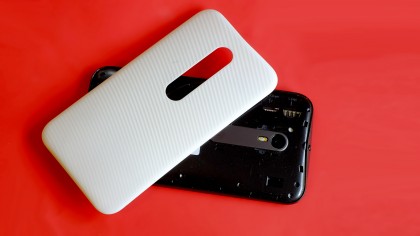
This is the first of the Moto G family to offer any weather resistance, and it goes all the way with IPx7 certification. That means you can dunk it in water up to 1m deep and leave it there for 30 minutes without having to leave it in a bag of rice afterwards, praying it’s not dead.
Look at the back cover and you’ll see that this is almost impossibly simple. A little border of rubber sits on certain parts of the backplate, sealing off slots that need protection.
What’s more impressive is that the sockets on the exposed parts of the Moto G don’t need this. I’m talking about the microUSB socket and the headphone jack. Like all the best waterproof phones, these are automatically designed not to let in water, and it takes all the pain out of water resistance.
Just a couple of years ago, even top-end phones like the Sony Xperia Z2 needed flaps to protect the ports you used on a daily basis. It got old pretty quick.
That the Moto G manages to side-step this annoyance, at this price, is commendable. And it’s going to make us come down pretty hard on any water resistant phones that don’t make the same moves in the future.
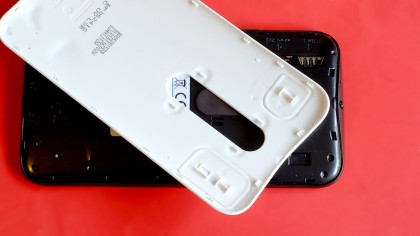
The other new hardware feature is customisation. Buy the Moto G from a network and you may only have a choice between white or black (network dependent). But order from the Moto Maker website and you can pick the colour of the backplate and the little metal ‘accent’ on the back that holds the camera lens. There are 10 colours of each part to choose from.
Water resistance and core customisation aren’t things I normally expect from mid-range phones. But that doesn’t mean the Moto G feels like it belongs in a class above. It doesn’t, and certainly not at £200.
The Moto G is a chunky, largely plastic phone. Some of you may not like the ridged style when compared with the various soft-touch and simple matt finishes Motorola used in its previous E and G-series phones. But, hey, it’s what we get.
The Moto G design is best described as ‘perfectly fine’. Pretty unexciting, right? It feels well made and its curved design helps hide its 11.6mm thickness. But it doesn’t feel expensive, and is a little large for a 5-inch phone. If you want it to stick out, be sure to have a look at Moto Maker before ordering.
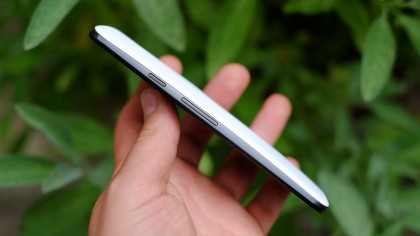
Screen
Some of you may have expected Motorola to dramatically upgrade the screen in this third-generation Moto G. It’s begging for a 1080p screen, right?
Well, it doesn’t have one. The 2015 Moto G has a 1280 x 720 pixel IPS LCD screen just like the last version. If you’re willing to go with a lesser-known brand, you can get a 1080p screen without paying all that much more. Just look at the Honor 6 and Vodafone Smart Prime 6 for a couple of examples.
This remains a mostly satisfying screen, though. It’s large enough to be well-suited to playing games, browsing the internet and displaying media, rather than being for ‘the basics’ only. While the slight pixellation will seem obvious to the more eagle-eyed among you, sharpness is pretty good.
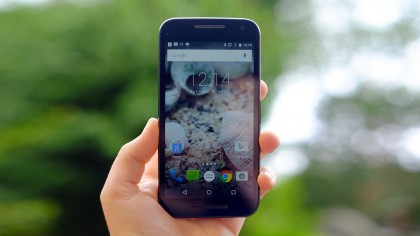
The real important question is, has anything changed? This is an odd one to tackle, as I discovered that the screens of the 16GB and 8GB version Moto Gs are substantially different.
The 8GB, 1GB RAM Moto G has a screen that looks a lot like the 2014 edition. It has relaxed, easy-going colours and a warm colour temperature that’s easy on the eyes, but gives whites a slight orange/yellow skew.
Conversely, the 16GB, 2GB RAM edition has dumped the warm skew in favour of much purer, whiter whites. While one approach is not categorically better than the other, this version does look a bit more striking.
The question is whether Motorola is using a different panel supplier for these Moto G subsets, or whether it’s just the luck of the draw which style you’ll get. Both are perfectly good, but I’d favour the punchier tone of the 16GB Moto G.
As it’s topped with Gorilla Glass 3, the screen also provides good fingerprint resistance (an oleophobic coating), and outdoors visibility is perfectly fine too.
Key features, interface and performance
The Moto G 2015 isn’t a features powerhouse, but that’s not the idea. Just like all the Moto G models, it includes the bits it thinks you’ll appreciate while leaving out the ones Motorola thinks you probably won’t need. Or even notice.
It’s not a Samsung, that’s for sure. On the hit list, the Moto G has all the usual things like GPS, Wi-Fi and so on, but it doesn’t have NFC or an IR transmitter. I get the feeling most people don’t know what the latter is for (it generally mimics a home entertainment remote), but NFC’s omission is a bit more contentious.
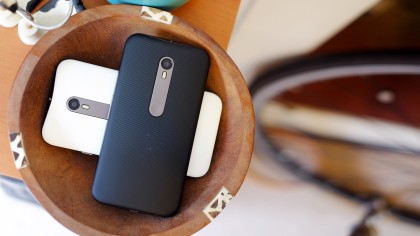
It means hooking the Moto G up to certain wireless accessories (speakers, headphones, cameras) will be a bit fiddlier, and also rules-out being able to use Android Pay, the Google equivalent to Apple Pay. This would let you pay for a packet of crisps and a coffee with your phone. Sounds a bit like fluff? Exactly. Those are the bits the Moto G leaves out.
However, you do get 4G mobile internet and the neat faff-free waterproofing I talked about earlier. It’s all about priorities, and the Moto G’s are roughly in the right order.
What else do you get? Well, there are two main flavours of Moto G. There’s one with 8GB storage and another with 16GB. The more expansive version will give you room for a handful of apps and games as well as an Instagram account’s worth of mobile phone pictures. You’re much more likely to need a microSD card if you pick the smaller-storage Moto G.
Performance
While both phones have the same Snapdragon 410 CPU, the 8GB version has 1GB RAM and the 16GB version 2GB.
Here’s a bit I need to stress: there are palpable performance benefits to the 2GB version. You’ll feel them throughout the interface, but obvious examples include a smoother camera preview, less time for apps to load when the phone is doing other tasks, and fewer disjointed transitions when the phone is ‘catching up’ with itself.
There’s none of this in the 1GB Moto G. Its performance is charmingly smooth, but there is mild creakiness. Tellingly, though, it’s nothing like the performance hit I’ve heard from multiple first-hand sources and experienced myself in older Moto Gs since the move to Android Lollipop.
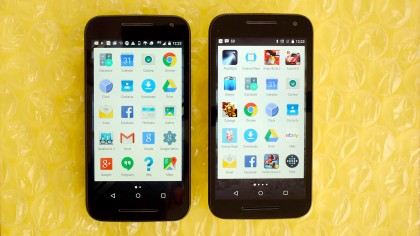
To put it bluntly, many old Moto Gs are slow these days. Is it planned obsolescence? Or are the older phones simply unable to keep up with the new Google software?
There are reasons to believe both stories. On the cynical, “Motorola is desperate for us to upgrade so it has killed the old Moto Gs” front, the Snapdragon 410 CPU used in the new model isn’t much more powerful than the Snapdragon 400 used in 2013’s Moto Gs.
Both are quad-core 1.2GHz chipsets with modest Adreno GPUs that won’t challenge top-end mobile CPUs from the past few years. The difference is that where the Snapdragon 400 uses 32-bit Cortex-A7 cores, the Snapdragon 410 uses native 64-bit Cortex-A53 ones.
These are from the same family of cores used in top-end Snapdragon 810 devices like the HTC One M9, but there they are used for everyday ‘low-power’ tasks before the meatier cores kick in.
The Geekbench benchmark results tell you about the progress made in the two-and-change years since the Snapdragon 400 was the king of cheapo phone CPUs. Where you can get 1390 points out of a Snapdragon 400, the Moto G (1GB) scores 1590 points.
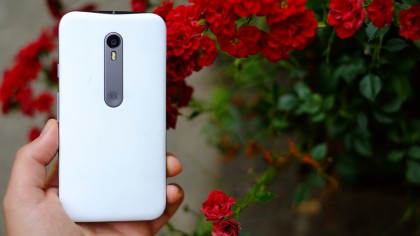
So has Motorola done a number on older Moto G owners? A big point in Motorola’s favour is the common lag affecting many Android Lollipop phones that would have performed perfectly well with Android 4.4. Until this year, unless your phone had a poorly optimised UI, 1GB RAM and a Snapdragon 400 were enough to guarantee very solid performance.
No longer, though, with many 1GB RAM budget phones suffering from mild-to-severe performance issues. I’m looking at you, LG G4C, EE Harrier Mini, Moto G 2014, and so on.
Given some of the issues in this company, the performance of both models is pretty great. I’d naturally pick the 16GB/2GB model if I had the choice, but would be happy to live with either.
Software
Motorola’s decision not to load down Android with lots of custom UI bits and apps is a positive one. The look of the Moto G’s interface is pure Android Lollipop, with just a few tweaks here and there to add the odd juicy feature.
The visual design of Android Lollipop is great. It’s simple, friendly-looking and has cut out all extraneous interface elements so that your screen is filled with content rather than buttons, boxes and lines.
Perhaps the most obvious visual change in Lollipop, compared to KitKat, is that the apps menu is now presented on a ‘blank page’ of white rather than a patterned background. It may sound like a step backwards, but it offers great clarity. Despite lacking interface signposts and labels, it’s the most intuitive Android yet as long as you know basics, like what the soft keys do.
And who among you doesn’t these days, right?
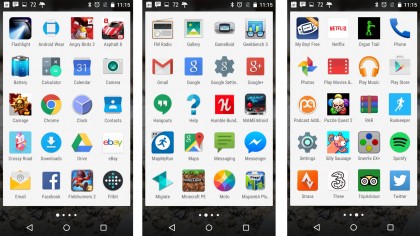
Moto customisations boil down to the Migrate app, camera app, Moto app, and the active display feature. The rest is pure Android.
Let’s start with the boring one: Migrate. This helps you move content from your old phone. Useful, prosaic, fine.
The Moto app brings together a bunch of features that previously had separate apps in Motorola phones. It’s a smart move to squish them into the one box: no-one likes bloatware. This lets you control the extra features Motorola has added, like a Do Not Disturb mode that will silence your phone in situations of your choice. Again, this is pretty common, but also useful.
The active display feature is one part that’s a little out of the ordinary. It’s a toned-down version of the always-on display of the Moto X, which shows the time and other bits of info on-screen while the phone is in standby.
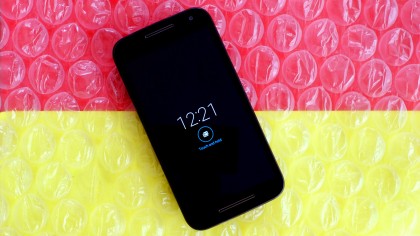
In the Moto G it turns part of the screen on when you get a notification and when you pick it up (most of the time, anyway). It gives you a brief glance at what’s going on with your phone without needing to bring it out of standby. Plus it gives you the time.
So why isn’t it on 24/7? It’s down to the sort of display the Moto G uses. It has an LCD screen, which uses a universal backlight. LEDs fire across the screen and their light passes through a matrix that spreads it over the display. Voila, the screen’s nice and bright. However, it means you can’t just light a tiny part of the screen.
OLED screens, on the other hand, have light-emissive pixels, letting them light up just a fraction of the surface, thereby also using just a fraction of the power. As much as the Samsung Galaxy S6’s OLED screen soundly outperforms the Moto X’s, all OLEDs have a few neat tricks up their sleeves.
What we like about the Moto G’s approach to side-order features like the active display is that they come across as very low-key. They don’t get in the way, and that’s great.
Battery life, media and the essentials
One aspect of the new Moto G is sneaky. The design appears to have dual, stereo front-facing speakers. These became all the rage after HTC put them into the original HTC One, reminding us that good phone speakers are absolutely worth having.
However, these aren’t stereo speakers. Only the bottom one acts as a main music/films/whatever speaker, with the top one used for calls only.
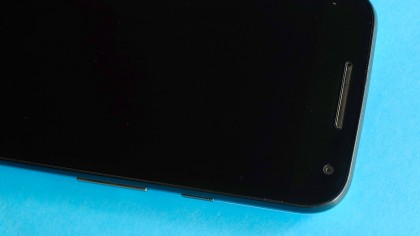
Before you scream at the internet that Motorola is duping us, their performance is perfectly fine. The earpiece speaker is loud and clear, with a fuller tone than we get from a lot of lower-mid range phones. Calls sound good.
There’s been a marginal improvement made to the main speaker too. Side-by-side with the 2014 Moto G, the 2015 version sounds slightly louder and has a little more mid-range ‘body’ to it.
It’s not HTC One M9-grade, though, and it becomes a little brash and harsh-sounding at top volume. In this more affordable class, the Alcatel OneTouch leads the pack when it comes to rich sound quality. The Moto G speaker does at least appear improved since last year, if by a tiny amount.
I also appreciate that Motorola has substantially toned-down the design of the speakers. The last Moto G had great big silvery bars signposting the speaker units, and they looked quite toy-like. They are more subtle in the 2015 Moto G, not to mention water resistant.
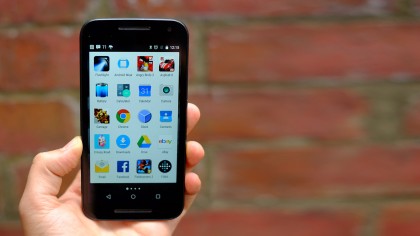
Without stereo drivers, the Moto G can’t achieve a stereo image when you hold the phone on its side to watch a film. It’s a shame. If video-watching and game-playing is a big hobby, be sure to consider the Huawei Ascend G7. It costs the same amount as the 16GB Moto G, but has a 5.5-inch screen, more power, and a metal body.
This being a Moto phone, you’ll want to download your own media player app before getting stuck-in The Moto G only has Google’s standard services preinstalled, and none are much cop at playing your own videos.
That’s the idea, though. The Moto G is a blank slate, and you can keep it blank if you like, or fill it up. It’s not as if other preinstalled apps give us something we can’t get on Google Play for free anyway, right?
Once you’re tooled up with the right app, you’ll find it lasts longer as a video player than any Moto G to date. In TechRadar’s standard battery test, playing a 90 minute MP4 file at full brightness, the 2015 Moto G lost 19% charge. That’s down from 26% in the (non-4G) 5-inch model from last year and 23% in the original 4.7-inch Moto G.
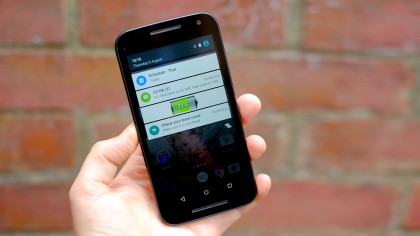
This is to using a larger battery, rather than the amazing efficiency of any new components used. The 2015 Moto G has a 2470mAh battery, while the older models have 2070mAh units. The 4G version of the last model bumped that up to 2390mAh, though, so should perform closer to this new one.
Confused? Don’t be. The Moto G has solid battery life and Motorola has corrected the misstep of not increasing battery size when it increased screen size to five inches back in 2014.
In everyday use, the Moto G’s stamina is solid, but not class-leading. With carefree use you’ll get a day and a bit off a charge. But to get two days’ use out of it you’ll need to use it lightly or make good use of the Battery Saver mode.
Now a default feature of Android, Battery Saver cuts down energy-sapping things like background data and location/GPS so that the Moto G zaps very little battery unless you’re actually using the phone.
Like last time, the Moto G’s battery is non-removable.
Camera
Camera quality was the biggest issue with the earliest Moto G phones. The first version’s camera was dreadful. But now Motorola has flipped that around, making it the single most impressive feature of the 2015 Moto G.
The Moto G has a 13-megapixel Sony IMX214 main sensor with an f/2.0 lens, and a 5-megapixel camera up front. This main camera sensor has been loads of times, most notably in the Nexus 6, OnePlus One and Huawei Ascend G7.
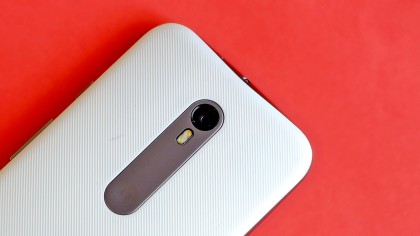
However, this might be one of the best applications of this core hardware I’ve seen. At the very least it’s immensely impressive for a phone that starts at £180.
For example, while similar hardware was used in the Nexus 6, the Moto G shoots a lot faster than the Nexus 6 did when TechRadar reviewed it. Shooting speed and low shutter lag are important factors in making a phone camera feel fun to use.
It also produces a lot more good shots than duds, and doesn’t take dull-looking pictures as soon as a cloudy sky appears.
In this respect the Moto G trashes two of its big-name rivals: the Sony Xperia M4 Aqua and HTC Desire 626. It both out-specs and out-performs the LG G4c too.
In daylight you get vibrant, natural colours. Punchy-looking photos that generally offer good contrast are the standard when shooting during the day. Detail is excellent too for a more affordable phone.

The Moto G impresses here because it matches a good sensor with solid processing. It doesn’t under-saturate colours in the way the OnePlus One tends (or at least tended) to, and is far quicker off the mark than the Nexus 6, as I’ve already mentioned.
As well as soundly beating similar competition from HTC, Sony and LG, I got to test the Moto G alongside the iPhone 6 and found that its metering system generally comes up with pretty similar results. That’s a very good thing.
The f/2.0 lens aperture also enables some neat shallow depth of field effects when you shoot close up, which is perfect for Instagram-bait nature shots. I was flat-out surprised with how great some of the Moto G shots look.

There is some room for improvement, though. If you switch the HDR mode to ‘on’ rather than leaving it on its (very solid) Auto setting, the high dynamic range effect is a bit too pronounced to look natural. The same is true of the original Moto G and the second-gem model. Motorola doesn’t seem to have updated its HDR algorithms much: maybe it’s time, eh?
The Moto G’s low-light and indoors lighting abilities aren’t going to worry top-tier phone cameras either. Without OIS or super-aggressive low-light processing, dark scenes stay looking pretty dark, and the noise reduction algorithm tends to favour maintaining detail over making your images look super-smooth and noise-free.
There is a dual-LED flash, however, which keeps your shots from looking washed-out should you need extra light. Judging by test portraits, it works pretty well and maintains natural-looking skin tones.

Motorola has even put impressive work into the selfie camera. It’s surprisingly great, far surpassing most entry-level 5-megapixel selfie cameras. And it can spar with the most expensive phones.
Faces appear bright and clear no matter the light conditions, white balance is generally on the money and it’s able to render fine beard hairs more clearly than any other 5-megapixel selfie camera in a £200 phone. There’s even a simulated flash selfie mode, but it tends to make people’s faces look cool (in colour temperature, not the other cool) and introduce more noise.
I’m starting to see why Motorola has had to ramp up the price of the Moto G. After two years of listening to complaints about camera quality, it has clearly gone in all guns blazing.
Are there elements to improve? Yes, but for a £180-200 phone it’s great.
Camera app
As before, the Moto G uses the custom Motorola camera app, but there’s one big change this time. When you call up the touch focus control, you’ll see it features an exposure dial. In some ways the Motorola camera app can feel fiddly. It has a less straightforward style than, say, the Samsung Galaxy S6’s app, relying on a rotary menu that’s not onscreen all the time.
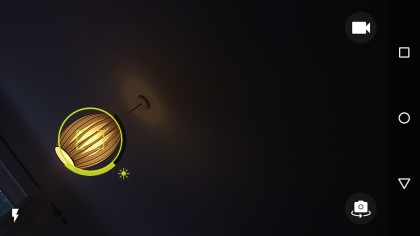
However, this is probably the best use of manual exposure compensation control I’ve seen in a phone.
It just works, letting you quickly alter the exposure level with a quick flick of a thumb. The preview is generally accurate too, although it doesn’t show the results of any HDR processing pre-shoot.
The camera upgrade also enables 1080p video recording, something not previously included. It uses software stabilisation, allows HDR during video and comes with a 720p slo-mo mode. It’s the full package.
Comparison
Moto G (2014)
As well as toning down the front-on desigN, the new Moto G makes a handful of fairly meaningful improvements. First, we get the more recent Snapdragon 410 CPU instead of the old 400 one.
Water resistance is in this year too.
The best bit, though, is the camera. The second Moto G’s was fairly good, but the new one is a whole league ahead. 2014 Moto Gs suffered from substantial lag, which doesn’t seem to affect the new models, particularly the 2GB RAM one.
HTC Desire 626
The HTC Desire take on the Moto G ideal is similar in some respects, but has a worse camera and battery life. These are two pretty important factors for any phone.
Is the software better? It depends on what you like. HTC Sense feels a bit dated in parts, but also offers more inbuilt features such as BlinkFeed and the new Smart Home widget.
One obvious draw is the Desire 626’s two-tone body design, but ultimately the Moto G feels like the better phone.
LG G4c
It’s the baby version of the LG G4. Except it’s nowhere near as powerful.
The LG G4c has specs very similar to the lower-end Moto G, but with current software it suffers from very annoying interface lag throughout. It’s a bit of a pain to use.
Battery life is good, but that doesn’t really make up for the lag. If LG sorts out the phone’s performance, it could be a contender, but I don’t see it trumping the Moto G.

Sony Xperia M4 Aqua
The other low-cost waterproof phone. Its waterproofing is good, and its design is slimmer and perhaps a bit slicker than the Moto G.
Its processor is more powerful too, with eight cores instead of four, and battery life is pretty good. However, the camera is a lot weaker. The specs sound the same, but actual camera performance is far weaker in the Sony.
General performance is also slightly better in the 2GB RAM Moto G, despite the lesser CPU. However, the Sony outperforms the 1GB version. Be careful about which version of M4 Aqua you end up with: most in the UK have only 8GB storage.
Samsung Galaxy A5
If you’re willing to spend £90 more, the Samsung Galaxy A5 is a pretty good alternative to the Moto G. It’s a good deal snazzier, with metal sides and a much slimmer body. Plus, the OLED screen gives you better screen contrast and more vibrant colours.
Not every part of the phone is better. Where the Moto G uses the Sony IMX214 camera sensor, the Galaxy A5 has the less advanced IMX135, so won’t be able to reach quite the same image quality and video heights.
However, extra £90 is an awful lot of money at this level. The two phones are similar in specs, but the Samsung is really in the next price class. It’s a strong contender if you can afford it.
Camera samples

















Verdict
The 2015 Moto G takes a slightly different approach to its predecessors, despite its initial similarities. Motorola is slowly taking the focus away from sheer value by offering more customisation and a camera that’s unusually good at the price.
As the phone is a little heavy and chunky compared with some rivals, this may make it a bit of a tough sell. However, the more expensive version in particular is a pure joy to use, featuring none of the performance/camera/software issues seen in most of the rivals from LG, HTC and Sony.
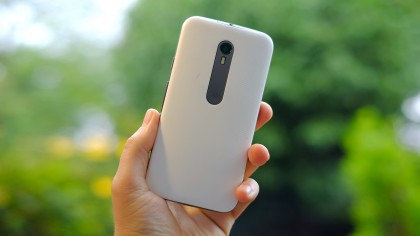
There are carrier-branded and lesser-brand phones at this level also worth checking out, like the Honor 6. But the Moto G remains an obvious recommendation.
We liked
I expected a camera upgrade, but I’ve been full-on charmed by the Moto G camera. It simply outdoes the similarly-specced affordable phone cameras at the price, with far more consistent performance and better image quality.
The water resistance is almost as well-implemented as I could have hoped. While you need to make sure the seals are in place, most people will never need to take the backplate off. You can pretty much forget the water resistance is there, as the charge and headphone ports are water resistant by themselves.
I love the Moto G approach to software too. The vanilla Android Lollipop look plus a few Moto upgrades is a good combo, providing a very clean experience. Performance is near-flawless in the 2GB RAM version, and very good in the 1GB.
We dislike
I miss the days when we could talk about the Moto G like the bargain of the century. Those days are gone. While this phone is still among the very best, most companies offer similar specs within a similar price range.
I wish Motorola had stayed a bit more aggressive with the specs of the screen. A 1080p Moto G at the price of the 2GB RAM version would have been as aggressive as the original Moto G from 2013.
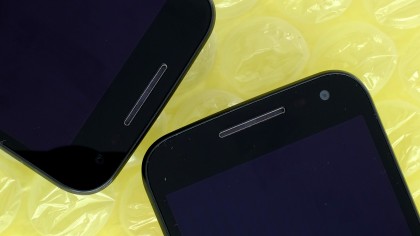
I would really have liked a bit more improvement in the speakers too. Despite appearances, the Moto G doesn’t have stereo speakers, and while sound quality has improved a bit, a bit more finesse and warmth in the sound would have been nice.
Verdict
The Moto G carries the series’ torch in style. It has shed the ultra-bargain style that used to be the main attraction, but hitting the mark in every category makes it superior to virtually all rivals.
![]()
Related Posts
December 6, 2021
7+ Web Design Trends for 2022: Which Will You Use?
December 6, 2021
The 10 Best WordPress Booking Plugins to Use On Your Website
December 6, 2021
How to Use a Web Cache Viewer to View a Cached Page
November 6, 2021
10 Modern Web Design Trends for 2022
November 6, 2021
Best Free SSL Certificate Providers (+ How to Get Started)
November 6, 2021
How to Design a Landing Page That Sends Conversions Skyrocketing
November 6, 2021
What Are the Best WordPress Security Plugins for your Website?
October 6, 2021
Your Guide to How to Buy a Domain Name
October 6, 2021
How to Build a WordPress Website: 9 Steps to Build Your Site
September 6, 2021
10 Best Websites for Downloading Free PSD Files
September 6, 2021
HTML5 Template: A Basic Code Template to Start Your Next Project
September 6, 2021
How Much Does It Cost to Build a Website for a Small Business?
September 6, 2021
A List of Free Public CDNs for Web Developers
September 6, 2021
6 Advanced JavaScript Concepts You Should Know
August 6, 2021
10 Simple Tips for Launching a Website
August 6, 2021
25 Beautiful Examples of “Coming Soon” Pages
August 6, 2021
10 Useful Responsive Design Testing Tools
August 6, 2021
Best-Converting Shopify Themes: 4 Best Shopify Themes
July 6, 2021
What Is Alt Text and Why Should You Use It?
July 6, 2021
24 Must-Know Graphic Design Terms
June 6, 2021
How to Design a Product Page: 6 Pro Design Tips
April 6, 2021
A Beginner’s Guide to Competitor Website Analysis
April 6, 2021
6 BigCommerce Design Tips For Big Ecommerce Results
April 6, 2021
Is WordPress Good for Ecommerce? [Pros and Cons]
March 6, 2021
Make Websites Mobile-Friendly: 5 Astounding Tips
March 6, 2021
Shopify vs. Magento: Which Platform Should I Use?
March 6, 2021
Top 5 Web Design Tools & Software Applications
February 6, 2021
Website Optimization Checklist: Your Go-To Guide to SEO
February 6, 2021
5 UX Design Trends to Dazzle Users in 2021
February 6, 2021
What Is the Average Page Load Time and How Can You Do Better?
February 6, 2021
Choosing an Ecommerce Platform That Will Wow Customers
February 6, 2021
7 Best Practices for Crafting Landing Pages with Forms
February 6, 2021
7 B2B Web Design Tips to Craft an Eye-Catching Website
January 6, 2021
Mobile-Friendly Checker | Check Your Site’s Mobile Score Now
January 6, 2021
8 Tips for Developing a Fantastic Mobile-Friendly Website
December 6, 2020
How to Add an Online Store to Your Website [4 Ways]
December 6, 2020
5 UX Design Tips for Seamless Online Shopping
November 6, 2020
Ecommerce Website Essentials: Does Your Site Have All 11?
November 6, 2020
5 Small Business Website Essentials You Need for Your Site
November 6, 2020
Your Website Redesign Checklist for 2020: 7 Steps for Success
May 1, 2020
Psychology of Color [Infographic]
April 21, 2020
How to start an online store that drives huge sales
January 3, 2020
5 Lead Generation Website Design Best Practices
March 6, 2019
6 Reasons You Should Redesign Your Website in 2019
March 6, 2019
7 Web Design Trends for 2019
February 19, 2019
Who owns the website/app source code, client or developer
February 7, 2019
Don’t Let Your Domain Names Expire in 2019
January 8, 2019
2019 Website Development Trends To Note
October 6, 2017
How Web Design Impacts Content Marketing
October 6, 2017
How to Choose a Navigation Setup
August 6, 2017
Why User Experience Matters to Marketing
July 6, 2017
5 Ways Web Design Impacts Customer Experience
September 6, 2016
How to Learn Angular
September 6, 2016
The Excuses for Not Having a Website (Infographic)
September 6, 2016
How to Build an Award-Winning Web Design Team
September 6, 2016
13 Free Data Visualization Tools
August 6, 2016
How Selling Pastries Helped Us Design a Better Product
August 6, 2016
11 Sites to Help You Find Material Design Inspiration
July 4, 2016
How to change free wordpress.com url
April 6, 2016
The 5 Best Free FTP Clients
April 6, 2016
7 Free UX E-Books Worth Reading
March 6, 2016
Can Handwritten Letters Get You More Clients?
December 10, 2015
Star Wars Week: How to create your own Star Wars effects for free
December 6, 2015
20 "Coming Soon" Pages for Inspiration
December 6, 2015
6 Free Tools for Creating Your Own Icon Font
December 6, 2015
9 Useful Tools for Creating Material Design Color Palettes
November 6, 2015
20 Free UI Kits to Download
November 6, 2015
50 Web Designs with Awesome Typography
November 6, 2015
When to Use rel="nofollow"
November 6, 2015
7 Free Books That Will Help You Become More Productive
November 6, 2015
50 Beautiful One-Page Websites for Inspiration
November 6, 2015
Circular Images with CSS
October 6, 2015
Lessons Learned from an Unsuccessful Kickstarter
October 6, 2015
5 Games That Teach You How to Code
October 6, 2015
Cheatsheet: Photoshop Keyboard Shortcuts
October 6, 2015
An Easy Way to Create a Freelance Contract for Your Projects
October 6, 2015
50 Design Agency Websites for Inspiration
September 29, 2015
JB Hi-Fi shutting the book on ebooks
September 24, 2015
Opinion: Quick, Quickflix: It's time to give yourself the flick
September 24, 2015
New Star Wars 360-degree video is among first on Facebook
September 21, 2015
Apple purges malicious iPhone and iPad apps from App Store
September 12, 2015
Apple's new Live Photos feature will eat up your storage
September 12, 2015
The latest Windows 10 Mobile preview has been delayed
September 12, 2015
IBM buys StrongLoop to add Node.js development to its cloud
September 8, 2015
Fake Android porn app takes your photo, then holds it ransom
September 6, 2015
50 Restaurant Websites for Inspiration
September 6, 2015
Zero UI — The Future of Interfaces
September 6, 2015
50 Beautiful Websites with Big Background Images
September 6, 2015
Infographic: 69 Web Design Tips
September 6, 2015
Free Windows 10 Icons
September 2, 2015
Instagram turns itself into a genuine messaging service
August 11, 2015
In Depth: How Microsoft taught Cortana to be more human
August 11, 2015
Windows 10 price, news and features
August 11, 2015
Windows 10's broken update introduces endless reboot loop
August 11, 2015
Windows 10 races to 27m installs
August 11, 2015
Windows 10 IoT Core gets first public release
August 10, 2015
iOS Tips: How to backup iPhone to an external drive
August 10, 2015
Windows 8.1 RT finally getting Windows 10 Start Menu
August 10, 2015
How to use Windows Hello
August 10, 2015
Review: Moto Surround
August 9, 2015
8 of the best free VPN services
August 8, 2015
Use Firefox? Mozilla urges you update ASAP
August 7, 2015
Mac Tips: Apple Mail: How to remove the Favorites Bar
August 7, 2015
How to make the OS X dock appear faster
August 7, 2015
Review: BQ Aquaris E45 Ubuntu Edition
August 7, 2015
Review: Acer Liquid Jade Z
August 6, 2015
How to reinstall Linux
August 6, 2015
How to reinstall Windows
August 6, 2015
Updated: Apple Music: release date, price and features
August 6, 2015
Social News Websites for Front-End Developers
August 6, 2015
10 Free JavaScript Books
August 6, 2015
50 Beautiful Blog Designs
August 6, 2015
Animated SVG Pipes Effect
August 6, 2015
Launching Your First App
August 5, 2015
Windows 10 goes freemium with paid apps
August 5, 2015
Updated: Week 1 with Windows 10
August 5, 2015
Mac Tips: How to manage Safari notifications on Mac
August 5, 2015
Microsoft Sway may kill the PowerPoint presentation
August 4, 2015
Microsoft gives Outlook on the web a new look
August 4, 2015
Mac OS X vulnerable to new zero-day attack
August 4, 2015
Windows 10 users warned of two scams
August 4, 2015
Microsoft's Docs.com is now available to everyone
August 3, 2015
Mac Tips: How to edit the Favorites sidebar on Mac
August 3, 2015
Updated: Windows 10 price, news and features
July 29, 2015
Review: HP ProDesk 405 G2
July 29, 2015
Hands-on review: HP Elite x2 1011
July 29, 2015
Hands-on review: Updated: Windows 10 Mobile
July 29, 2015
Review: Updated: Nvidia Shield Android TV
July 28, 2015
LIVE: Windows 10 launch: Live Blog!
July 28, 2015
How to prepare for your upgrade to Windows 10
July 28, 2015
Review: Updated: Windows 10
July 28, 2015
Review: Updated: HP Pro Tablet 608
July 28, 2015
Review: Heat Genius
July 28, 2015
Hands-on review: Moto X Play
July 28, 2015
Hands-on review: Moto X Style
July 28, 2015
Hands-on review: Moto G (2015)
July 28, 2015
Review: 13-inch MacBook Air (early 2015)
July 28, 2015
Hands-on review: OnePlus 2
July 28, 2015
Review: LG 65EG960T 4K OLED
July 28, 2015
Mac Tips: How to share printers on Mac
July 27, 2015
Apple Music's arrival hasn't opened Pandora's box
July 26, 2015
Review: Garmin Swim
July 25, 2015
How to merge OS X contacts into an existing list
July 25, 2015
Hands-on review: UPDATED: ZTE Axon
July 24, 2015
Mac Tips: How to zoom in on a Mac
July 24, 2015
What Windows 10 means for the enterprise
July 24, 2015
Review: JBL Charge 2 Plus
July 24, 2015
Review: Acer Aspire S7
July 24, 2015
Review: Updated: Canon G3 X
July 24, 2015
Review: Updated: iPad Air 2
July 24, 2015
Review: Thinksound On1
July 24, 2015
Review: Asus Chromebook Flip
July 24, 2015
Review: Garmin Forerunner 225
July 23, 2015
Review: Garmin nuvi 68LM
July 23, 2015
Review: Samsung Galaxy S6 Active
July 23, 2015
Review: Bowers and Wilkins P5 Wireless
July 23, 2015
Review: Dell XPS 15 (2015)
July 21, 2015
Review: Fuji S9900W
July 21, 2015
Review: Updated: Fitbit Surge
July 21, 2015
Review: UE Roll
July 21, 2015
Hands-on review: Ubik Uno
July 20, 2015
Review: Samsung HW-J650
July 20, 2015
Updated: 40 best Android Wear smartwatch apps 2015
July 20, 2015
Review: Acer Chromebook C740 review
July 20, 2015
Review: Huawei Talkband B2
July 20, 2015
Review: Dell Venue 10 7000
July 20, 2015
Review: Intel Core i7-5775C
July 17, 2015
Mac Tips: How to delete locked files on Mac
July 17, 2015
Review: Pebble Time
July 16, 2015
Microsoft just made Windows XP even less secure
July 16, 2015
Windows 8.1 RT is getting an update this September
July 16, 2015
OS showdown: Windows 10 vs Windows 8.1 vs Windows 7
July 16, 2015
Review: Acer CB280HK
July 15, 2015
Windows 10 is ready for new laptops and PCs
July 15, 2015
Explained: How to take a screenshot in Windows
July 15, 2015
Office for Windows 10 appears in latest build
July 14, 2015
Review: ZTE Axon
July 14, 2015
Review: ViewSonic VP2780-4K
July 14, 2015
Hands-on review: SanDisk Connect Wireless Stick
July 14, 2015
Review: Oppo PM-3
July 14, 2015
Review: BT 11ac Dual-Band Wi-Fi Extender 1200
July 14, 2015
Review: Fuji X-T10
July 13, 2015
How to build an SEO strategy for your business
July 13, 2015
Review: Lenovo ThinkPad Yoga 15
July 13, 2015
Review: Audio-Technica ATH-MSR7
July 13, 2015
Review: Garmin NuviCam LMT-D
July 13, 2015
Review: Dell Inspiron 13 7000
July 13, 2015
Hands-on review: AstroPi SenseHAT
July 13, 2015
Hands-on review: EE Rook
July 13, 2015
Hands-on review: Updated: HTC Vive
July 12, 2015
Here's the ultimate software list for PC fanatics
July 10, 2015
How to use the new Photos app for Mac
July 10, 2015
Windows 10 Insider Preview Build 10166 available now
July 10, 2015
Splunk spends big on cybersecurity acquisition
July 10, 2015
Making Windows 10 apps just got a whole lot easier
July 10, 2015
Review: Lenovo LaVie Z 360
July 9, 2015
OS X El Capitan public beta available right now
July 9, 2015
Microsoft finally unveils Office 2016 for Mac
July 9, 2015
Review: Updated: Chromecast
July 9, 2015
Review: Updated: Tesco Hudl 2
July 9, 2015
Review: Lenovo ThinkPad E550
July 9, 2015
Review: Updated: Google Nexus 6
July 8, 2015
What you need to know about Windows Server 2016
July 7, 2015
Microsoft to hike enterprise cloud pricing
July 6, 2015
Hacking Team end up being totally 0wned
July 6, 2015
Review: HP Pro Slate 12
July 6, 2015
Review: Samsung 850 Pro 2TB
July 6, 2015
Review: Asus RT-AC87U
July 6, 2015
Review: Jawbone UP2
July 6, 2015
Reimagining the Web Design Process
July 6, 2015
50 Clean Websites for Inspiration
July 6, 2015
15 Free Books for People Who Code
July 6, 2015
Web Storage: A Primer
July 6, 2015
A Look at Some CSS Methodologies
July 3, 2015
6 Essential Mac Mouse and Trackpad Tips
July 2, 2015
How to install a third party keyboard on Android
July 2, 2015
Review: UPDATED: Asus Zenfone 2
July 2, 2015
Review: Alienware 13
July 2, 2015
Review: HP DeskJet 1010
July 1, 2015
5 issues we want Apple Music to fix
June 13, 2015
Cortana will get its own button on Windows 10 PCs
June 12, 2015
Windows 10 will come with universal Skype app
June 12, 2015
iPad music production: 18 Best apps and gear
June 12, 2015
Windows 10 all set for early enterprise struggle
June 12, 2015
Review: Garmin VIRB Elite
June 11, 2015
Review: Updated: Nvidia Shield Tablet
June 11, 2015
Review: Nokia Lumia 635
June 10, 2015
Microsoft brings more online tweaks to Office 365
June 10, 2015
Mac Tips: How to use Screen Sharing in Mac OS X
June 9, 2015
Hands-on review: Meizu M2 Note
June 9, 2015
Hands-on review: EE 4GEE Action Camera
June 9, 2015
Review: Toshiba 3TB Canvio external hard drive
June 9, 2015
Review: Olympus SH-2
June 8, 2015
Hands-on review: Updated: Apple CarPlay
June 8, 2015
UPDATED: iOS 9 release date, features and news
June 8, 2015
Review: Updated: Roku 2
June 8, 2015
Review: Updated: PlayStation Vue
June 8, 2015
Review: Dell PowerEdge R730
June 8, 2015
Review: Canon SX710 HS
June 7, 2015
UPDATED: iOS 9 release date, features and rumors
June 7, 2015
Review: Lenovo S20-30
June 6, 2015
Free Writing Icons
June 6, 2015
15 CSS Questions to Test Your Knowledge
June 6, 2015
The Best CSS Reset Stylesheets
June 6, 2015
How CSS Specificity Works
June 5, 2015
'Delay' is a new feature in Windows 10
June 5, 2015
Review: Beyerdynamic Custom One Pro Plus
June 5, 2015
Latest SEO Marketing tools
June 5, 2015
Review: Nvidia Shield Android TV
June 5, 2015
Review: Honor 4X
June 5, 2015
Review: In Depth: Oppo R5
June 3, 2015
Hands-on review: Huawei P8 Lite
June 3, 2015
How To: How to create eBooks on a Mac
June 3, 2015
Review: Updated: Tidal
June 3, 2015
Review: Canon 750D (Rebel T6i)
June 2, 2015
Review: Updated: Asus ZenWatch
June 2, 2015
Review: Alcatel OneTouch Idol 3
June 2, 2015
Review: Updated: Nokia Lumia 1520
June 2, 2015
Review: Updated: Yotaphone 2
June 2, 2015
Review: Updated: Nokia Lumia 625
June 2, 2015
Review: Creative Muvo Mini
June 1, 2015
Review: Acer TravelMate P645 (2015)
June 1, 2015
Hands-on review: Corsair Bulldog
May 29, 2015
In Depth: NetApp: a requiem
May 29, 2015
July is looking definite for Windows 10 release
May 29, 2015
Hands-on review: Google Photos
May 28, 2015
Mac Tips: The 16 best free GarageBand plugins
May 28, 2015
Review: Canon 760D (Rebel T6s)
May 27, 2015
Review: Lenovo Yoga 3 14
May 27, 2015
Hands-on review: Serif Affinity Photo
May 27, 2015
Review: Garmin Vivoactive
May 26, 2015
Review: Datacolor Spyder5 Elite
May 26, 2015
Hands-on review: Sony Xperia Z3+
May 26, 2015
Review: Epson BrightLink Pro 1410Wi
May 26, 2015
Review: Technics Premium C700
May 26, 2015
Review: Canon EOS M3
May 26, 2015
Review: Updated: HTC One M9
May 26, 2015
Review: Updated: Sony Xperia Z3 Compact
May 25, 2015
Review: Updated: New Nintendo 3DS
May 25, 2015
Updated: 50 best Mac tips, tricks and timesavers
May 25, 2015
Updated: Windows email: 5 best free clients
May 25, 2015
Instagram is planning to invade your inbox
May 25, 2015
Review: Updated: Foxtel Play
May 24, 2015
How Windows 10 will change smartphones forever
May 24, 2015
Review: Vodafone Smart Prime 6
May 24, 2015
Review: Updated: iPad mini
May 22, 2015
Office Now may be Cortana for your work life
May 22, 2015
Review: Updated: Lenovo Yoga 3 Pro
May 22, 2015
Review: Microsoft Lumia 640 LTE
May 22, 2015
Review: Updated: Fitbit Flex
May 21, 2015
Updated: Best free Android apps 2015
May 21, 2015
Review: Asus ZenBook Pro UX501
May 21, 2015
Review: Sennheiser Momentum In-Ear
May 20, 2015
Hands-on review: UPDATED: Asus Zenfone 2
May 20, 2015
OS X 10.11 release date, features and rumors
May 18, 2015
Updated: Best free antivirus software 2015
May 18, 2015
iPhone 6S rumored to launch as soon as August
May 18, 2015
Microsoft ready to pounce and acquire IFS?
May 17, 2015
5 of the most popular Linux gaming distros
May 16, 2015
Review: Acer Chromebook 15 C910
May 16, 2015
Review: Lenovo ThinkPad X1 Carbon (2015)
May 16, 2015
Review: Polk Nue Voe
May 16, 2015
The top 10 data breaches of the past 12 months
May 16, 2015
Hands-on review: Updated: LG G4
May 16, 2015
Review: Updated: Quickflix
May 16, 2015
Review: LG Watch Urbane
May 16, 2015
Review: Razer Nabu X
May 16, 2015
Hands-on review: Updated: Windows 10
May 16, 2015
Review: UPDATED: Moto X
May 16, 2015
Review: Updated: Moto G (2013)
May 12, 2015
Review: TomTom Go 50
May 12, 2015
Review: Updated: Moto G (2014)
May 12, 2015
Review: Garmin Vivofit 2
May 12, 2015
Review: Asus Transformer Book Flip TP300LA
May 11, 2015
Review: MSI GT80 Titan
May 11, 2015
Review: Monster SuperStar BackFloat
May 9, 2015
Review: Updated: Apple Watch
May 7, 2015
5 million internet users infected by adware
May 7, 2015
Review: Updated: New MacBook 2015
May 6, 2015
Android M will be shown at Google IO 2015
May 6, 2015
Review: Epson WorkForce Pro WF-4630
May 6, 2015
Review: Master & Dynamic MH40
May 6, 2015
How to Use Gulp
May 6, 2015
Getting Started with Command-Line Interfaces
May 6, 2015
What It’s Like to Contribute to WordPress
May 6, 2015
Ultimate Guide to Link Types for Hyperlinks
May 6, 2015
11 Things You Might Not Know About jQuery
May 5, 2015
Hands-on review: Updated: PlayStation Now
May 5, 2015
Review: Lenovo ThinkPad Yoga 12
May 5, 2015
Review: Updated: iPad Air
May 5, 2015
Review: Panasonic SZ10
May 5, 2015
Review: Updated: Fetch TV
May 4, 2015
Review: Cambridge Audio Go V2
May 3, 2015
Review: Lightroom CC/Lightroom 6
May 2, 2015
5 of the most popular Raspberry Pi distros
May 1, 2015
Review: PlayStation Vue
May 1, 2015
Hands-on review: Updated: Microsoft HoloLens
April 30, 2015
Build 2015: Why Windows 10 may not arrive until fall
April 29, 2015
The biggest announcements from Microsoft Build 2015
April 29, 2015
Hands-on review: TomTom Bandit
April 29, 2015
Hands-on review: EE Harrier Mini
April 28, 2015
Review: Samsung NX500
April 28, 2015
Hands-on review: LG G4
April 28, 2015
Review: Patriot Ignite 480GB SSD
April 28, 2015
Hands-on review: EE Harrier
April 28, 2015
Review: Linx 10
April 28, 2015
Review: 1&1 Cloud Server
April 26, 2015
Hands-on review: Acer Iconia One 8
April 25, 2015
How to run Windows on a Mac with Boot Camp
April 24, 2015
Dropbox Notes poised to challenge Google Docs at launch
April 24, 2015
Hands-on review: Acer Aspire E14
April 24, 2015
Hands-on review: UPDATED: Valve Steam Controller
April 24, 2015
Review: Acer Iconia One 7
April 23, 2015
Windows 10 just revived everyone's favorite PC game
April 23, 2015
Google opens up Chromebooks to competitors
April 23, 2015
Here's how Outlook 2016 looks on Windows 10
April 23, 2015
Hands-on review: Updated: Acer Liquid M220
April 23, 2015
Hands-on review: Acer Aspire Switch 10 (2015)
April 23, 2015
Hands-on review: Acer Aspire R 11
April 22, 2015
Review: Alienware 17 (2015)
April 22, 2015
Hands-on review: Updated: HP Pavilion 15 (2015)
April 21, 2015
This is how Windows 10 will arrive on your PC
April 21, 2015
Review: iMac with Retina 5K display
April 21, 2015
Review: Epson XP-420 All-in-One
April 18, 2015
Google Now brings better search to Chrome OS
April 17, 2015
Review: Epson Moverio BT-200
April 17, 2015
Review: Pentax K-S2
April 16, 2015
Updated: Android Lollipop 5.0 update: when can I get it?
April 15, 2015
Hands-on review: Updated: Huawei P8
April 15, 2015
Review: SanDisk Ultra Dual USB Drive 3.0
April 15, 2015
Review: Updated: LG G3
April 15, 2015
Review: Updated: LG G3
April 15, 2015
Review: Crucial BX100 1TB
April 13, 2015
iOS 8.4 beta reveals complete Music app overhaul
April 13, 2015
Linux 4.0: little fanfare for a tiny new release
April 13, 2015
Achievement unlocked: Microsoft gamifies Windows 10
April 13, 2015
Best Android Wear smartwatch apps 2015
April 13, 2015
Review: Acer Aspire R13
April 12, 2015
Review: TP-Link Archer D9
April 10, 2015
Microsoft's new browser arrives for Windows 10 phones
April 10, 2015
Review: LG UltraWide 34UC97
April 9, 2015
Office now integrates with Dropbox on the web
April 9, 2015
Now you can buy video games with Apple Pay
April 9, 2015
Updated: iOS 8 features and updates
April 9, 2015
Microsoft's stripped down Nano Server is on the way
April 8, 2015
Skype Translator gets even more features
April 8, 2015
Windows mail services hit by widespread outages
April 8, 2015
Review: UPDATED: Amazon Echo
April 8, 2015
Hands-on review: Dell Venue 10 7000
April 8, 2015
Review: Updated: OS X 10.10 Yosemite
April 7, 2015
Google's GMeet could kill teleconferencing
April 7, 2015
Is Redstone the first Windows 10 update?
April 7, 2015
Next peek at Windows Server 2016 due next month
April 7, 2015
Review: Acer Aspire Switch 11
April 7, 2015
Review: Adobe Document Cloud
April 6, 2015
Hands-on review: Updated: New MacBook 2015
April 6, 2015
Freebie: 100 Awesome App Icons
April 6, 2015
Six Revisions Quarterly Report #1
April 6, 2015
A Modern Approach to Improving Website Speed
April 6, 2015
Disable Text Selection with CSS
April 4, 2015
Review: Nikon D7200
April 3, 2015
Amazon Prime video now streams to any Android tablet
April 3, 2015
Review: Google Cardboard
April 3, 2015
Review: MSI WS60
April 2, 2015
Chrome users can now run 1.3 million Android apps
April 2, 2015
See Windows 10 Mobile running on an Android handset
April 2, 2015
Review: Mini review: Macphun Noiseless Pro 1.0
April 2, 2015
Review: Intel SSD 750 Series 1.2TB
April 2, 2015
Review: BenQ TreVolo
April 2, 2015
Hands-on review: Nikon 1 J5
April 1, 2015
Microsoft launches Windows 10 music and video apps
April 1, 2015
Review: mini review: Sony XBA-H1
December 19, 2014
Review: CoPilot Premium sat nav app
December 19, 2014





























































































































































































































































































































































































































































































































































































